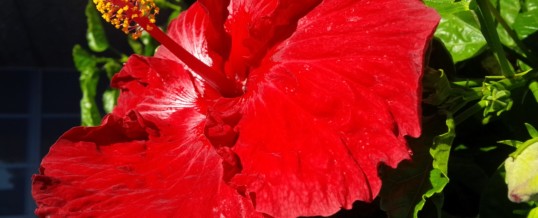
As my colleagues and I travel on our rounds to service tropical office plants, we are asked by our clients almost daily whether it is a good idea to bring the beautiful flowering plants from decks and porches inside for the winter. It is certainly tempting to give it a try; much time and care has gone into keeping these plants beautiful over the warm months of spring and summer. At this time of year, many still have blooms and are strong and healthy. Most people know that all it takes is one good overnight frost to cause permenent damage and at this time of year it could happen suddenly. While it is certainly possible to overwinter tropical outdoor plants, most people are disappointed with the state of these plants come spring. The majority of outdoor flowering plants are annuals in our climate zone. Others may be perennial, such as some species of Hibiscus, but still require a dormant season as they would experience in their natural habitat. We try to fool Mother Nature by keeping the plants indoors in the warmth, but we cannot mimic the proper environment the plants require to stay healthy. The condition that the plant struggle with the most is the lack of humidity through the winter months. When the heating system come on in our homes, the air becomes extremely dry. The temperature remains too constant, nothing at all like the change in temperature that happens outdoors when night falls. The number of daylight hours drops considerably as well. The result is a stressed plant; its leaves turn yellow and fall off. New growth is weak, and blooms are rare. It becomes susceptible to pest infestations with spider mites and scale. When the plant is returned to the outdoors in the spring, people are often disappointed that it does not bloom as well as the previous year, or its foliage is not as dense, full and green.
Something else to consider is that most plants that have been outdoors all summer may have insects such as white fly or thrip. These may spread to and attack your indoor tropical plants.
Here are some tips that may help the plants survive the winter:
- Keep the plants in the brightest location possible. Even if they have been kept in the shade of a porch outside, they are accustomed to receiving far more light than they will receive indoors.
- Try to add humidity to the air, either with a cool mist humidifier or even a pan of water near the plant.
- Water more frequently; the soil will dry out much more quickly indoors
- Consider adding some grow lights to the area where the plants are kept. Even an additional hour or two of light each day will help
- Do not fertilize during the winter; the plant goes dormant to a degree and will not utilize the fertilizer. Excess fertilizer will damage the roots.
- Monitor the plant for insects and treat quickly.
Share
SEP
2014
